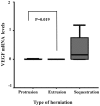Molecular profile of major growth factors in lumbar intervertebral disc herniation: Correlation with patient clinical and epidemiological characteristics
- PMID: 28260009
- PMCID: PMC5364887
- DOI: 10.3892/mmr.2017.6221
Molecular profile of major growth factors in lumbar intervertebral disc herniation: Correlation with patient clinical and epidemiological characteristics
Abstract
The involvement of growth factors (GFs) in the pathogenesis of lumbar intervertebral disc (ID) herniation and the spontaneous resorption of herniated ID fragments remains only partially elucidated. A simultaneous assessment of the transcript levels of numerous GFs and their association with clinical and epidemiological profiles of human ID herniation would provide valuable insight into the biology and clinical course of the disease. In the present study, we examined simultaneously the transcript levels of vascular endothelial growth factor (VEGF), transforming growth factor β1 (TGF‑β1), basic fibroblast growth factor 2 (bFGF2), platelet derived growth factor (PDGF) isoforms and receptors, epidermal growth factor (EGF) and insulin growth factor‑1 (IGF‑1) in herniated and control ID specimens and investigated their correlation with the clinicopathological profiles of patients suffering from symptomatic lumbar ID herniation. GF mRNA expression levels were determined by RT-qPCR in 63 surgical specimens from lumbar herniated discs and 10 control ID specimens. Multiple positive correlations were observed between the transcript levels of the GFs examined in the ID herniation group. VEGF mRNA expression was significantly increased in the protruding compared with the extruded discs. Intense and acute pain significantly upregulated the PDGF transcript levels. Significant negative correlations were observed between the patient body mass index and the transcript levels of VEGF and PDGF receptors. Our findings support the hypothesis of the involvement of GFs in the natural history of ID herniation. GFs synergistically act in herniated IDs. Increased VEGF expression possibly induces the neovascularization process in the earliest stages of ID herniation. PDGF‑C and ‑D play a role in the acute phase of radiculopathy in a metabolic response for tissue healing. A molecular effect, in addition to the biomechanical effect of obesity in the pathogenesis of ID herniation is also implied.
Figures



Similar articles
-
Transcript levels of major MMPs and ADAMTS-4 in relation to the clinicopathological profile of patients with lumbar disc herniation.Eur Spine J. 2011 May;20(5):781-90. doi: 10.1007/s00586-010-1573-9. Epub 2010 Sep 22. Eur Spine J. 2011. PMID: 20857147 Free PMC article.
-
Effect of cartilaginous endplates on extruded disc resorption in lumbar disc herniation.PLoS One. 2018 Apr 17;13(4):e0195946. doi: 10.1371/journal.pone.0195946. eCollection 2018. PLoS One. 2018. PMID: 29664923 Free PMC article.
-
Effects of basic fibroblast growth factor on spontaneous resorption of herniated intervertebral discs. An experimental study in the rabbit.Spine (Phila Pa 1976). 1999 May 15;24(10):940-5. doi: 10.1097/00007632-199905150-00003. Spine (Phila Pa 1976). 1999. PMID: 10332782
-
[Significance of cell autophagy in resorption of lumbar disc herniation].Zhongguo Gu Shang. 2018 Apr 25;31(4):386-390. doi: 10.3969/j.issn.1003-0034.2018.04.017. Zhongguo Gu Shang. 2018. PMID: 29772868 Review. Chinese.
-
The natural history of lumbar disc herniation and radiculopathy.Joint Bone Spine. 2002 Mar;69(2):155-60. doi: 10.1016/s1297-319x(02)00385-8. Joint Bone Spine. 2002. PMID: 12027305 Review.
Cited by
-
Identifying the Potential Role and Prognostic Value of the Platelet-Derived Growth Factor Pathway in Kidney Renal Clear Cell Carcinoma.J Oncol. 2022 Mar 17;2022:9498010. doi: 10.1155/2022/9498010. eCollection 2022. J Oncol. 2022. PMID: 35342405 Free PMC article.
-
The Immune Privilege of the Intervertebral Disc: Implications for Intervertebral Disc Degeneration Treatment.Int J Med Sci. 2020 Feb 24;17(5):685-692. doi: 10.7150/ijms.42238. eCollection 2020. Int J Med Sci. 2020. PMID: 32210719 Free PMC article. Review.
-
IGF Signaling in Intervertebral Disc Health and Disease.Front Cell Dev Biol. 2022 Feb 1;9:817099. doi: 10.3389/fcell.2021.817099. eCollection 2021. Front Cell Dev Biol. 2022. PMID: 35178405 Free PMC article. Review.
-
Obesity ‑ a risk factor for increased COVID‑19 prevalence, severity and lethality (Review).Mol Med Rep. 2020 Jul;22(1):9-19. doi: 10.3892/mmr.2020.11127. Epub 2020 May 5. Mol Med Rep. 2020. PMID: 32377709 Free PMC article. Review.
-
Prevalence, clinical predictors, and mechanisms of resorption in lumbar disc herniation: a systematic review.Orthop Rev (Pavia). 2024 Sep 21;16:121399. doi: 10.52965/001c.121399. eCollection 2024. Orthop Rev (Pavia). 2024. PMID: 39944739 Free PMC article.
References
MeSH terms
Substances
LinkOut - more resources
Full Text Sources
Other Literature Sources
Medical
Miscellaneous

